Refracting Telescope
What’s a Refracting Telescope? A Refracting Telescope has an optical lens and an eyepiece lens used for observation. Refracting Telescopes collect light through the optical lens and bend the light to create an image. An optical eyepiece magnifies the image.
Refracting telescopes are good choices for Dark Sky Objects, like distant nebulas and galaxies. There are better choices than a refracting telescope for planetary or moon viewing.
Is a Refracting Telescope the best telescope for you? Let’s dig into the specifics and sort this out.
Table of Contents
Refracting Telescope Invention
The Refracting Telescopes invention is mired in controversy. In 1608, Hans Lipperhey, a spectacle-maker, placed two lenses into a coaxial cylinder and created a refracting telescope. Lipperhey created the telescope for military use and land surveying.
In 1609, Galileo Galilei modified the “Danish perspective glass” and created a fully functioning Refracting Telescope with a magnification value of three times (3X). Galileo continued to hone the quality of the lens manufacturing and increased the lens magnification to 30X. The increase in magnification allowed astronomers to turn the telescope towards the night skies.
While other scientists found celestial objects sooner than Galileo, Galileo was skilled at documenting and publishing his findings.
How Does A Refracting Telescope Work?
Refracting telescopes have benefits and drawbacks. Let’s look at the basic principle of a Refracting Telescope. A refracting telescope is the “simplest” kind of telescope.
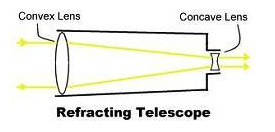
The image above represents a Refracting Telescope. The Convex Lens is aimed toward the night sky. The Concave lens acts as an eyepiece for the astronomer. Let’s look at the difference between the two types of lenses.
Convex Lens
- Light enters the Refracting Telescope through a Convex (Objective) Lens.
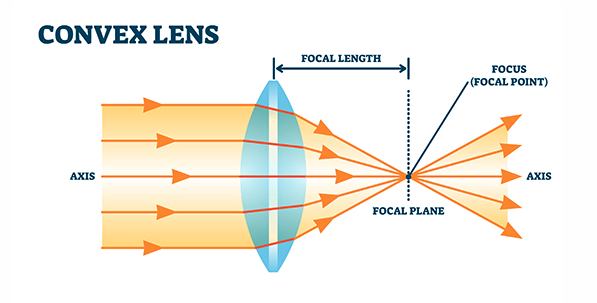
- The light enters the telescope on a parallel plane to the axis and begins to converge as they pass through the convex lens.
- The light’s direction is modified based on the curvature and thickness of the lens and redirected toward the center of the telescope’s cylinder.
- The lens is “thicker” in the center than it is at the end of the lens.
- The Focal Lenth is the distance from the center of the convex lens to the center of the Focal Plane.
- The Focal Length is fixed. The Focal Length is based on the size of the lens, the curvature of the lens, and the refractive index (RI) of the lens.
- As the diameter of the Convex lens increases, so does the overall length of the telescope.
- As the lens size increases, the ability of the telescope to collect light increases
- When the light reaches a total convergence point, it passes through an area called the “Focal Plane.” In the Focal Plane, a “virtual” image of the object the telescope is pointed at is created. The Eyepiece (Concave Lens) will take over from here.
Concave Lens
- Light exits the telescope through the Concave (eyepiece) Lens
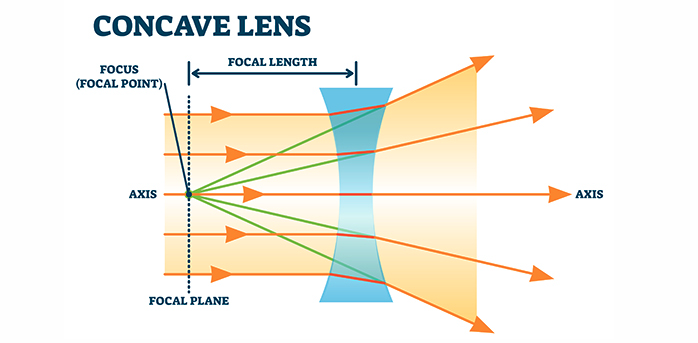
- The Concave Lens spreads the light back “out,” the opposite of the Convex Lens.
- The Concave Lens also has a fixed Focal Length, just like the Convex Lens has a fixed Focal Length.
- The Concave lens position is mechanically adjusted to bring an object into focus in the eyepiece.
- When a focus adjustment is made, the distance between the Concave Lens and the Focal Plane of the Objective Lens is modified.
- The goal is to place the Concave Lens the exact position where the image is focused.
Refracting Telescope Weakness
Refracting telescopes have two key weaknesses.
- The light is bent as it passes through two lenses. The bending of the light creates Chromatic Aberration.
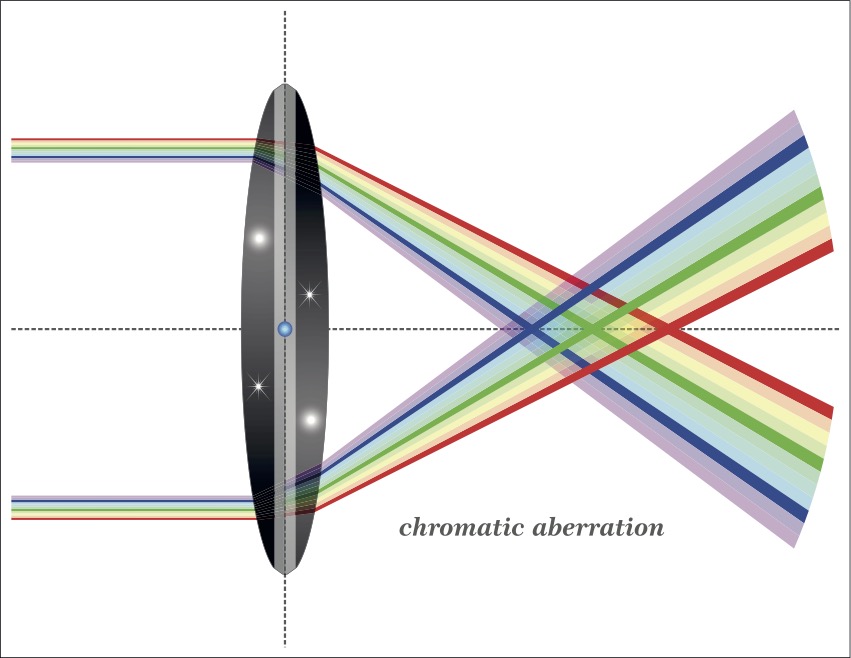
- Chromatic Aberration develops when light passes through an objective lens.
- Light, as we see it, is made up of many different wavelengths.
- Some wavelengths will pass through the Lens faster than other wavelengths. The differing speeds create a kind of “color shadow.”
Here is an example of a chromatic aberration image:
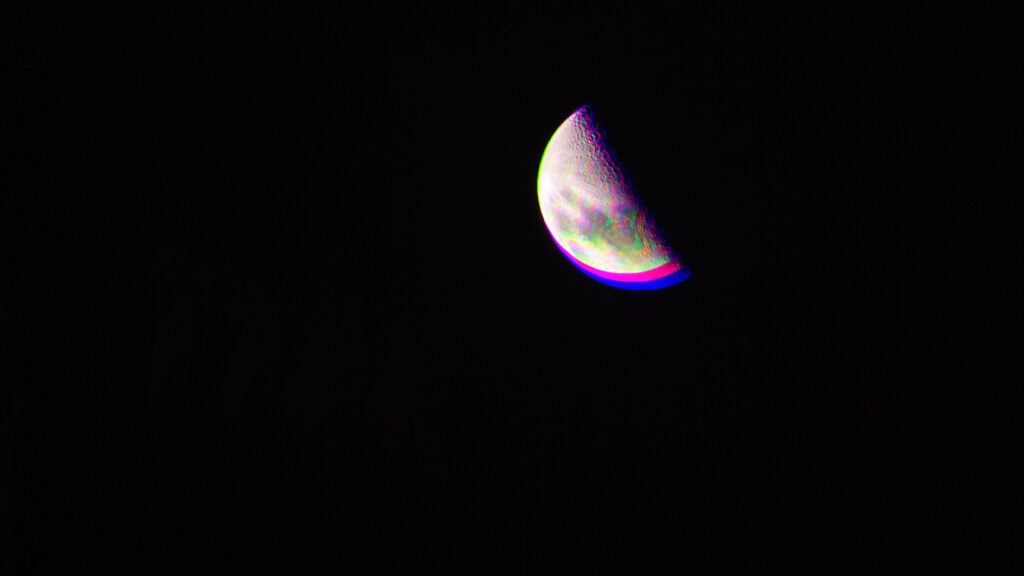
The image above reveals the effect of Chromatic Aberration when viewed through a telescope. All the different colors of the spectrum don’t converge or focus at the same location.
- The amount of light entering the telescope is limited by the size of the Lens.
- In other types of telescopes (Reflectors and Catadioptric), the light is reflected around the inside of the telescope by mirrors.
- The greater reflection distance equates to longer focal lengths in Reflector and Catadioptric telescopes. The light is (literally) reflecting from one end of the telescope back to the other end of the telescope.
- The bigger the objective Lens, the longer the focal path.
- Refractors don’t have mirrors to reflect the light, so the lens size restricts the Focal Length.
- Bigger is better, but as the size of the Lens increases, so too does the weight of the Lens, lens manufacturing errors, and the required Length of the telescope.
- The Lens itself absorbs some of the light. Less light reaches the eyepiece.
Refracting Telescope Benefits
- The telescope’s cylinder is wholly enclosed, leaving less of a chance for debris to end up inside the telescope.
- No need to collimate (realign) the Lens
- Inexpensive
- Lightweight
- Minimal image Distortion
Different Types of Refracting Telescopes
The weakness of the Refracting Telescope is well-understood. The most common type of refractor telescope is an Achromatic design.
Achromatic (Doublet)
A Refracting telescope with at least two lenses (two objective Lenses and one eyepiece.) Entry-level telescope. Chromatic Aberration is a challenge.
- A second lens is located directly behind the objective lense. The dual Lens has a different refractive index than the first lense. The second lense will bring red and blue light into focus on the same Plane.
- The Celestron StarSense Explorer LT 80AZ is an Achromatic Refracting Telescope.
- A low-cost entry into astronomy, an Achromatic refracting telescope can start as low as $50.
Apochromatic Lenses (Triplet)
A Refracting Telescope with at least three lenses (three objective lenses and one eyepiece.)
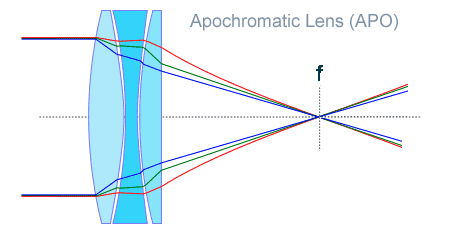
An Apochromatic Refracting Telescope isn’t necessarily an entry-level telescope. An additional lens has been added to reduce or eliminate chromatic Aberration.
- A third lens is added in front of the objective Lens. The third Lens has a different refractive index than the objective Lens and the doublet lens. The third Lens will bring the light wave for green onto the same Plane as blue and red.
- The Orion 9534 ED80T CF is a Triplet Apochromatic Telescope. It will cost you approximately $900, plus another $200 for a mount. Be careful of the total weight of the telescope, any gear attached to the telescope should be at most 50% of the total weight capacity of the mount.
- The addition of the third Lens increases the price of an Apochromatic Refractor telescope. Expect to part with anywhere from $500 to $3000.
Refracting Telescopes Wrap up
Refracting telescopes are a good choice for beginners just getting into astronomy. A low price point combined with ease of setup and transportation all combine into an excellent package.
Intermediate astronomers might be best suited to investigate an Apochromatic Refracting telescope, provided they have identified their astronomy objectives before purchasing this type of telescope.
